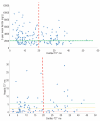In search of the optimal iron chelation therapy for patients with thalassemia major
- PMID: 21193427
- PMCID: PMC3012756
- DOI: 10.3324/haematol.2010.034397
In search of the optimal iron chelation therapy for patients with thalassemia major
Figures


Comment on
-
Deferasirox, deferiprone and desferrioxamine treatment in thalassemia major patients: cardiac iron and function comparison determined by quantitative magnetic resonance imaging.Haematologica. 2011 Jan;96(1):41-7. doi: 10.3324/haematol.2009.019042. Epub 2010 Sep 30. Haematologica. 2011. PMID: 20884710 Free PMC article.
-
Continued improvement in myocardial T2* over two years of deferasirox therapy in β-thalassemia major patients with cardiac iron overload.Haematologica. 2011 Jan;96(1):48-54. doi: 10.3324/haematol.2010.031468. Epub 2010 Nov 11. Haematologica. 2011. PMID: 21071497 Free PMC article.
References
-
- Borgna-Pignatti C, Rugolotto S, De Stefano P, Zhao H, Cappellini MD, Del Vecchio GC, et al. Survival and complications in patients with thalassemia major treated with transfusion and deferoxamine. Haematologica. 2004;89(10):1187–93. - PubMed
-
- Telfer P, Coen PG, Christou S, Hadjigavriel M, Kolnakou A, Pangalou E, et al. Survival of medically treated thalassemia patients in Cyprus. Trends and risk factors over the period 1980–2004. Haematologica. 2006;91(9):1187–92. - PubMed
-
- Ladis V, Chouliaras G, Berdousi H, Kanavakis E, Kattamis C. Longitudinal study of survival and causes of death in patients with thalassemia major in Greece. Ann NY Acad Sci. 2005;1054:445–50. - PubMed
-
- Telfer P. Update on survival in thalassemia major. Hemoglobin. 2009;33 (Suppl 1):S76–80. - PubMed
Publication types
MeSH terms
Substances
LinkOut - more resources
Full Text Sources

